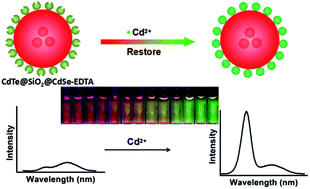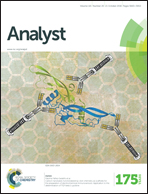Fabrication of an “ion-imprinting” dual-emission quantum dot nanohybrid for selective fluorescence turn-on and ratiometric detection of cadmium ions†
Abstract
In this work, we have fabricated a new dual-emission quantum dot (QD) nanohybrid for fluorescence ratiometric determination of cadmium ions (Cd2+) in water samples, where the “turn-on” model and “ion-imprinting” technique were incorporated simultaneously. The nanohybrid probe was composed of green-emitting CdSe QDs covalently linked onto the surface of silica nanoparticles embedded with red-emitting CdTe QDs. The chemical etching of ethylene diamine tetraacetic acid (EDTA) at the surface produced specific Cd2+ recognition sites and quenched the green fluorescence of outer CdSe QDs. Upon exposure to different amounts of Cd2+, the green fluorescence was gradually restored, whereas the inner red fluorescence remained constant. As a consequence, an obviously distinguishable fluorescence color variation (from red to green) of the probe solution was observed. Under the optimized conditions, the developed ratiometric sensor displayed a linear response range from 0.1 to 9 μM with a detection limit of 25 nM (S/N = 3) for Cd2+, which could offer an alternative sensing approach for the highly sensitive and selective detection of heavy metal ions.


 Please wait while we load your content...
Please wait while we load your content...